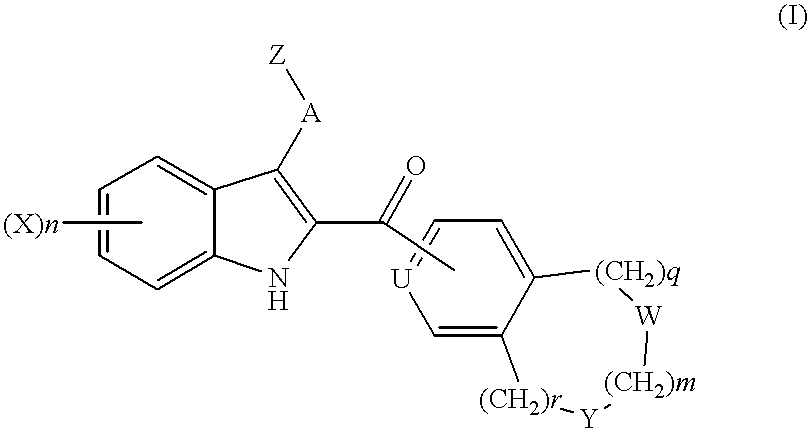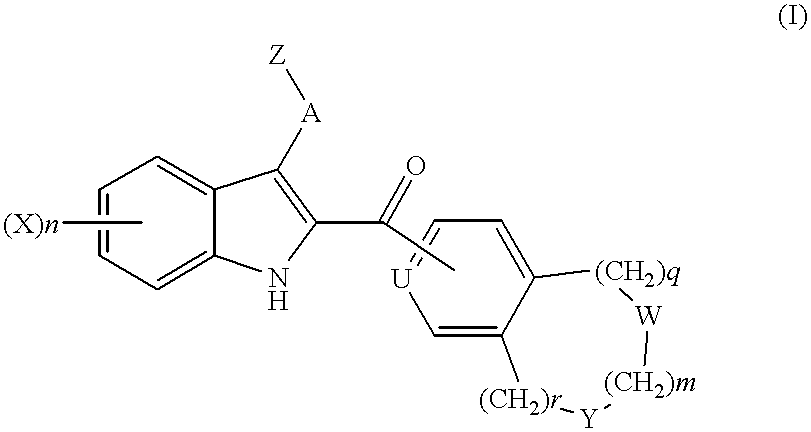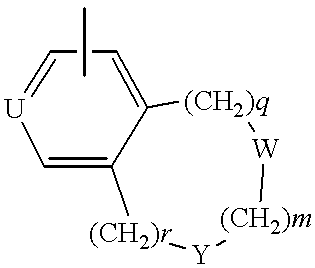Bicycliccarbonyl indole compounds as anti-inflammatory/analgesic agents
a technology of bicyclic carbonyl indole and anti-inflammatory, which is applied in the direction of heterocyclic compound active ingredients, biocide, drug compositions, etc., can solve the problems of limited therapeutic use of conventional nsaids, severe side effects, etc., and achieve the effect of inhibiting the contraction of prostaniod
- Summary
- Abstract
- Description
- Claims
- Application Information
AI Technical Summary
Problems solved by technology
Method used
Image
Examples
example 1
Methyl [6--chloro-2-[(5,6,7,8-tetrahydroisoquinolin-3yl)carbonyl]-1H-indol-3-yl]acetate
Step 1. Methyl trans -4-chloro-2-[(phenylsulfonyl)amino]cinnamate
To a solution of methyl trans-4-chloro-2-aminocinnamate (R. W. Carling et al., J.Med.Chem., 1993, 36, 3397., 30.7 g, 0.15 mol) and pyridine (36 ml, 0.45 mol) in dichloromethane (500 ml) was added benzenesulfonyl chloride (20 ml, 0.16 mol). After stirring for 20 h, methanol (50 ml) was added and the mixture was concentrated. The residual solids were dissolved in dichloromethane (700 ml) and washed with 2N aqueous HCl (150 ml), brine (150 ml) and dried (MgSO.sub.4). After removal of solvent, the residual solids were recrystallized from ethanol to give 40 g (76%) of the title compound as pale yellow solids.
.sup.1 H-NMR (CDCl.sub.3) .delta.: 7.77-7.71 (2H, m), 7.59-7.52 (1H, m), 7.48-7.35 (5H, m), 7.20 (1H, dd, J=2.0, 8.4 Hz), 6.85 (1H, br s), 6.15 (1H, d, J=15.8 Hz), 3.78 (3H, s).
Step 2. Methyl [6-chloro-2-[(5,6,7,8-tetrahydroisoquinoli...
example 2
[6--chloro-2-[(5,6,7,8-tetrahydroisoquinolin-3-yl)carbonyl]-1H-indol-3-yl]acetic acid
To a mixture of methyl [6-chloro-2-[(5,6,7,8-tetrahydroisoquinolin-3-yl)carbonyl]-1H-indol-3-yl]acetate (Example 1) in MeOH (20 ml)-THF (20 ml) was added 2N aqueous NaOH (0.6 ml, 1.2 mmol) at room temperature and the resulting mixture was heated at reflux temperature for 8 h. The mixture was cooled and concentrated. The residue was dissolved in water (20 ml) and washed with diethyl ether (20 ml.times.3). The aqueous layer was acidified with 2N aqueous HCl and extracted with ethyl acetate (40 ml.times.3). The combined organic layers were dried (MgSO.sub.4) and concentrated. The residue was recrystallized from ethyl acetate to afford 23.3 mg (60.7%) of the title compound as yellow solids.
m.p.: 225.degree. C.
IR (KBr): 3422, 1699, 1645, 1537, 1319, 1200, 1061, 991 cm.sup.-1.
.sup.1 H-NMR (DMSO-d.sub.6) .delta.: 12.30 (1H, br s), 8.52 (1H, s), 7.84 (1H, s), 7.78 (1H, d, 8.75 Hz), 7.74-7.09 (2H, m), 4.08 (...
example 3
Methyl [6-chloro-2-[(2,3-dihydro-1,4-benzodioxin-6-yl)carbonyl]-1H-indol-3-yl]acetate
The title compound was prepared according to the procedure described in step 2 of Example 1 from 6-bromoacetyl-2,3-dihydro-1,4-benzodioxine (J. Med. Chem. 1972, 15, 49) and methyl trans-4-chloro-2-[(phenylsulfonyl)amino]cinnamate (Example 1, step 1).
.sup.1 H-NMR (CDCl.sub.3) .delta.: 8.85 (1H, br s), 7.56 (1H, d, 8.56 Hz), 7.41-7.33 (4H, m), 7.15 (1H, dd, 8.56 Hz, 1.81 Hz), 6.98-6.94 (1H, m), 4.38-4.29 (4H, m), 3.88 (2H, s), 3.68 (3H, s).
PUM
| Property | Measurement | Unit |
|---|---|---|
| temperature | aaaaa | aaaaa |
| temperature | aaaaa | aaaaa |
| temperature | aaaaa | aaaaa |
Abstract
Description
Claims
Application Information
 Login to View More
Login to View More - R&D
- Intellectual Property
- Life Sciences
- Materials
- Tech Scout
- Unparalleled Data Quality
- Higher Quality Content
- 60% Fewer Hallucinations
Browse by: Latest US Patents, China's latest patents, Technical Efficacy Thesaurus, Application Domain, Technology Topic, Popular Technical Reports.
© 2025 PatSnap. All rights reserved.Legal|Privacy policy|Modern Slavery Act Transparency Statement|Sitemap|About US| Contact US: help@patsnap.com



